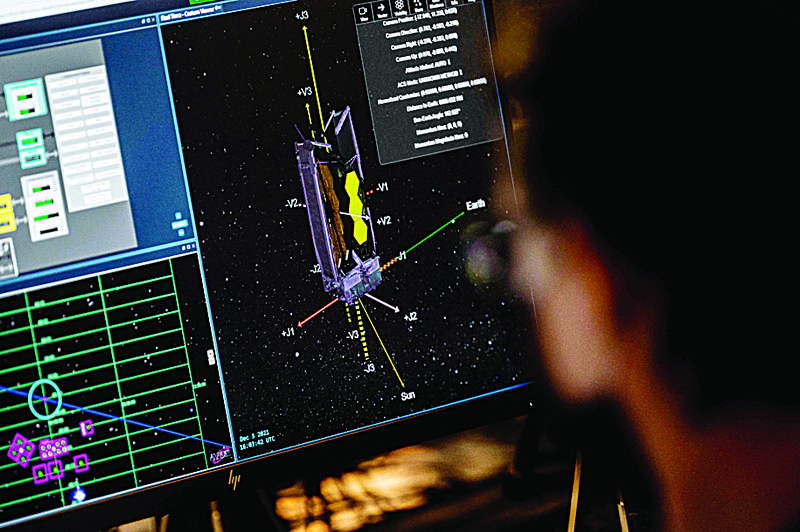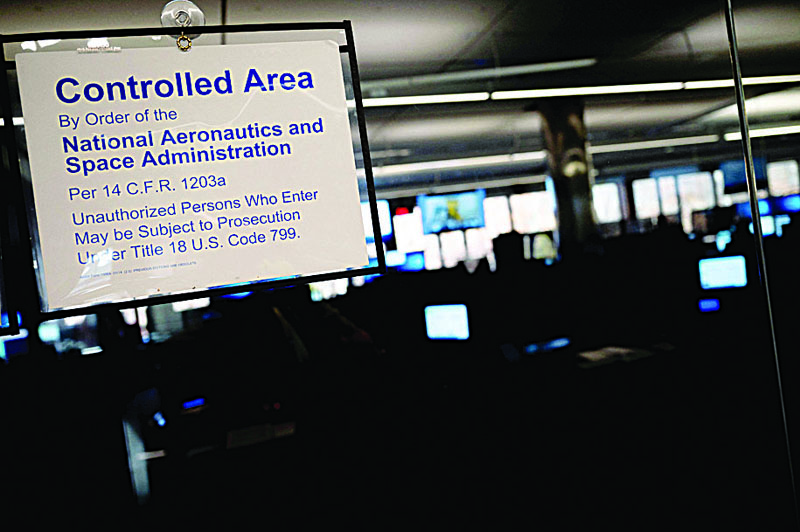 A technical drawing is seen on screen as Systems Engineers Christopher Murray (right) works at his console at the Webb Mission Office ahead of the James Web Space Telescope's launch at the Space Telescope Science Institute (STScI) in Baltimore, Maryland. - AFP Photos
A technical drawing is seen on screen as Systems Engineers Christopher Murray (right) works at his console at the Webb Mission Office ahead of the James Web Space Telescope's launch at the Space Telescope Science Institute (STScI) in Baltimore, Maryland. - AFP PhotosIt's been three decades in the making: the largest and most powerful telescope ever to be launched into space is finally ready to take up its orbit and beam back new clues to the origins of the Universe and Earth-like planets beyond our solar system. NASA's James Webb Space Telescope, named for a former director of the American space agency, follows in the footsteps of the legendary Hubble - but intends to show humans what the Universe looked like even closer to its birth nearly 14 billion years ago. In a recent Tweet chat, cosmologist and astrophysicist John Mather, who co-founded the Webb project, described the telescope's unprecedented sensitivity. "#JWST can see the heat signature of a bumblebee at the distance of the Moon," he tweeted.
All that power is needed to detect the weak glow emitted billions of years ago by the very first galaxies to exist and the first stars being formed. Hubble is capable of observing events that happened in space some 500 million years after the Big Bang, and Webb can go back even further to around 200 million years after that event. "This telescope is designed to answer the biggest questions in astronomy today," NASA astrophysicist Amber Straughn said in a 2017 TED talk.
"With Webb we hope to see these infant galaxies," she said, "and learn how galaxies grow over time." It will also give new information about nearly 5,000 exoplanets. While we know some planets outside our solar system are the right distance from their stars to make them habitable, scientists also want to know what their atmospheres are like and whether they could contain water. The ultimate goal is to find out whether Earth is unique or whether there are similar planets that could give rise to life.
 A sign hangs on Webb Mission Office announcing it is a controlled area ahead of the James Web Space Telescope's launch at the Space Telescope Science Institute (STScI) in Baltimore, Maryland.
A sign hangs on Webb Mission Office announcing it is a controlled area ahead of the James Web Space Telescope's launch at the Space Telescope Science Institute (STScI) in Baltimore, Maryland.Infrared vision
"There's a lot of excitement - we've been waiting for this moment for a long time," Pierre Ferruit, a project scientist from the European Space Agency (ESA), told AFP. The ESA and the Canadian Space Agency collaborated on Webb and Ferruit like thousands of his colleagues has been working on it for most of his career. Already, he said, researchers are competing for access. "Observation time is in very high demand. The ESA has received over a thousand applications for just the first year of operation," he said. "Even after 20 years, the questions Webb was made to answer are still just as pressing."
The telescope is unequalled in size and complexity. Its mirror measures 6.5 meters (21 feet) in diameter - three times the size of the one on the Hubble telescope - and is made of 18 hexagonal sections. It is so large that it had to be folded in order to fit into the Ariane 5 rocket that will carry it to its orbit. Once the telescope is in place, the challenge will be to fully deploy the mirror and a tennis-court-sized sun shield - a process that will take two weeks.
Its orbit around the sun will be 1.5 million kilometers from the Earth, much farther away than Hubble, which has been 600 kilometers above the Earth since 1990. The location of Webb's orbit is called the Lagrange 2 point and was chosen in part because it will keep the Earth, the Sun and the Moon all on the same side of its sun shield. "This will put it in darkness and in extreme cold," said Ferruit, conditions which will allow the telescope's infrared sensors to "see" without interference - a kind of observation of which the Hubble was incapable.
'Fill up the tanks'
The NASA project, launched in 1989, was originally expected to deploy in the early 2000s. But multiple problems forced delays and a tripling of the telescope's original budget with a final price tag of nearly 10 billion dollars (8.8 billion euros). Webb was built in the US and transported to its launch site in Kourou in French Guyana this year. Its launch date of December 18 was slightly delayed after a small accident in late November. An Ariane 5 rocket is now set to carry it into space on December 22, and it is estimated that it will take a month to reach its point of orbit. "All that's left is to fill up the gas tanks!" said Ferruit. - AFP










